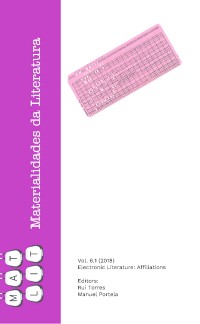Please use this identifier to cite or link to this item:
https://hdl.handle.net/10316.2/93355| DC Field | Value | Language |
|---|---|---|
| dc.contributor.author | Sabino, Ana | - |
| dc.date.accessioned | 2018-10-23T14:05:15Z | |
| dc.date.accessioned | 2020-10-04T00:49:27Z | - |
| dc.date.available | 2018-10-23T14:05:15Z | |
| dc.date.available | 2020-10-04T00:49:27Z | - |
| dc.date.issued | 2018 | - |
| dc.identifier.issn | 2182-8830 | - |
| dc.identifier.uri | https://hdl.handle.net/10316.2/44348 | - |
| dc.description.abstract | Os limites da página foram sendo historicamente marcados pelas restrições dos materiais em que o texto é inscrito. Na era digital, esses materiais deixaram de impor um limite físico, e os limites estão mais ligados às nossas práticas e convenções de leitura estabelecidas. No entanto, continuamos a ter que aceder ao texto em porções finitas — não conseguimos processar a infinitude textual que o espaço digital ilimitado permitiria. Assim sendo, surgem noções como as de janela ou frame (enquadramento), para tornar esse espaço ilimitado legível — à semelhança da prática antiga de ler e escrever em rolos (scrolls), que continham textos longos, mas eram lidos porção por porção. Hoje em dia, já não viramos simplesmente uma página deixando-a para trás; a nossa perceção é a de um constante reposicionar do enquadramento. Para questionar esta transição e as suas implicações, observaremos uma edição digital e outra em papel de Bartleby, the Scrivener por Herman Melville. | por |
| dc.description.abstract | The limits of the page have been historically set by the constrictions of the materials on which the text is inscribed. In the digital age, those materials no longer impose a physical limit, and the limits are more bound to what are our established reading practices and conventions. We still need to access the text in finite portions — we cannot process the infinitude of text that the limitless digital space would allow. Hence, notions as window or frame appear to make this infinite space readable — not unlike the ancient practice of reading and writing on a scroll, which contained large texts, but could only be read portion by portion. Nowadays, we no longer simply turn a page and leave it behind; in our perception, it is more like a frame is constantly being repositioned. In order to question this transition and its implications, we will be looking at a paper and a digital edition of Bartleby, the Scrivener by Herman Melville. | eng |
| dc.language.iso | eng | - |
| dc.publisher | Centro de Literatura Portuguesa | - |
| dc.publisher | Imprensa da Universidade de Coimbra | - |
| dc.rights | open access | - |
| dc.subject | reading surfaces | eng |
| dc.subject | graphical conventions | eng |
| dc.subject | page | eng |
| dc.subject | scroll | eng |
| dc.subject | frame | eng |
| dc.subject | superfícies de leitura | por |
| dc.subject | convenções gráficas | por |
| dc.subject | página | por |
| dc.subject | scroll | por |
| dc.subject | frame | por |
| dc.title | I would prefer not to turn the page: reading and writing in the unlimited digital space | por |
| dc.type | article | - |
| uc.publication.collection | Matlit v. 6, nº 1 | - |
| uc.publication.firstPage | 135 | - |
| uc.publication.issue | 1 | - |
| uc.publication.lastPage | 148 | - |
| uc.publication.location | Coimbra | - |
| uc.publication.journalTitle | MATLIT: Materialidades da Literatura | - |
| uc.publication.volume | 6 | por |
| dc.identifier.doi | 10.14195/2182-8830_6-1_9 | - |
| uc.publication.orderno | 9 | - |
| uc.publication.area | Artes e Humanidades | - |
| uc.publication.manifest | https://dl.uc.pt/json/iiif/10316.2/93355/263564/manifest?manifest=/json/iiif/10316.2/93355/263564/manifest | - |
| uc.publication.thumbnail | https://dl.uc.pt/retrieve/12072885 | - |
| item.grantfulltext | open | - |
| item.fulltext | With Fulltext | - |
| Appears in Collections: | Matlit | |
Files in This Item:
| File | Description | Size | Format | |
|---|---|---|---|---|
| i_would_prefer_not_to_turn_the_page.pdf | 1.47 MB | Adobe PDF |  |
Items in DSpace are protected by copyright, with all rights reserved, unless otherwise indicated.
